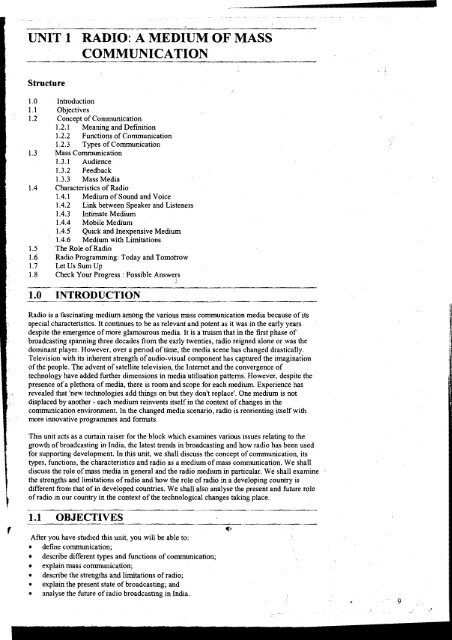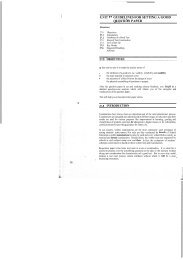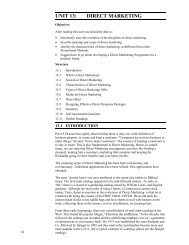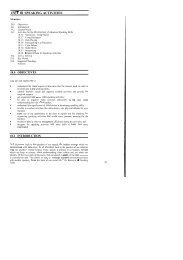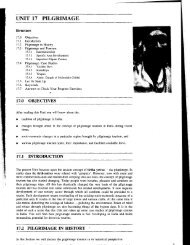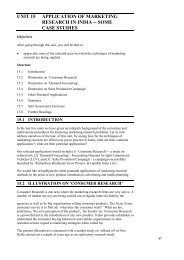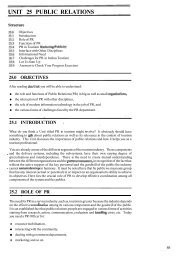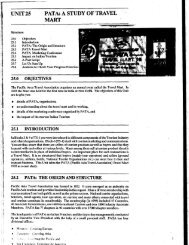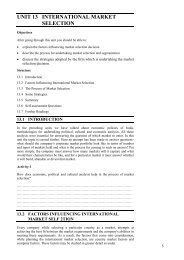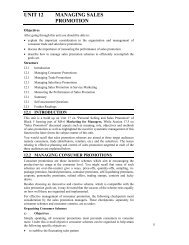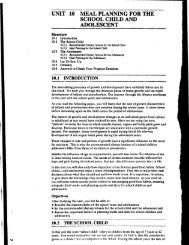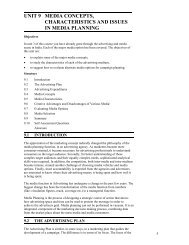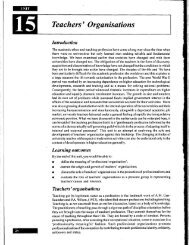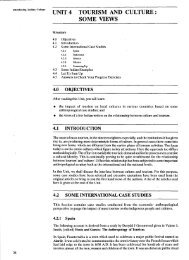UNIT 1 RADIO: A MEDIUM OF MASS COMMUNICATION - eGyanKosh
UNIT 1 RADIO: A MEDIUM OF MASS COMMUNICATION - eGyanKosh
UNIT 1 RADIO: A MEDIUM OF MASS COMMUNICATION - eGyanKosh
Create successful ePaper yourself
Turn your PDF publications into a flip-book with our unique Google optimized e-Paper software.
<strong>UNIT</strong> 1 <strong>RADIO</strong>: A <strong>MEDIUM</strong> <strong>OF</strong> <strong>MASS</strong><br />
<strong>COMMUNICATION</strong><br />
Structure<br />
Introduction<br />
Objectives<br />
Concept of Communication<br />
1.2.1 Meaning and Definition<br />
I .2.2 Functions of Communication<br />
1.2.3 Types of Communication<br />
Mass Communication<br />
1.3.1 Audience<br />
1.3.2 Feedback<br />
1.3.3 Mass Media<br />
Characteristics of Radio<br />
1.4.1 Medium of Sound and Voice<br />
1.4.2 Link between Speaker and Listeners<br />
1.4.3 Intimate Medium<br />
1.4.4 Mobile Medium<br />
1.4.5 Quick and Inexpensive Medium<br />
1.4.6 Medium with Limitations<br />
The Role of Radio<br />
Radio Programming: Today and Tomotrow<br />
Let Us Sum Up<br />
Check Your Progress : Possible Answers<br />
J<br />
1.0 INTRODUCTION<br />
Radio is a fascinating medium among the various mass communication media because of its<br />
special characteristics. It continues to be as relevant and potent as it was in the early years<br />
despite the emergence of more glamourous media. It is a truism that in the first phase of<br />
broadcasting spanning three decades from the early twenties, radio reigned alone or was the<br />
dominant player. However, over a period of time, the media scene has changed drastically.<br />
Television with its inherent strength of audio-visual component has captured the imagination<br />
of the people. The advent of satellite television, the Internet and the convergence of<br />
technology have added further dimensions in media utilisation patterns. However, despite the<br />
presence of a plethora of media, there is room and scope for each medium. Experience has<br />
revealed that 'new technologies add things on but they don't replace'. One medium is not<br />
displaced by another - each medium reinvents itself in the context of changes in the<br />
communication environment. In the changed media scenario, radio is reorienting itself with<br />
more innovative programmes and formats.<br />
This unit acts as a curtain raiser for the block which examines various issues relating to the<br />
growth of broadcasting in India, the latest trends in broadcasting and how radio has been used<br />
for supporting development. In this unit, we shall discuss the concept of communication, its<br />
types, functions, the characteristics and radio as a medium of mass communication. We shall<br />
discuss the role of mass media in general and the radio medium in particular. We shall examine<br />
the strengths and limitations of radio and how the role of radio in a developing country is<br />
different from that of in developed countries. We shall also analyse the present and future role<br />
of radio in our country in the context of the technological changes taking place.<br />
1.1 OBJECTIVES<br />
After you have studled this unit, you will be able to:<br />
define communication;<br />
describe different types and functions of communication;<br />
explain mass communication;<br />
describe the strengths and limitations of radlo;<br />
explain the present state of broadcastmg; and<br />
analyse the future of radio broadcasting in India.<br />
Ipt<br />
9<br />
2<br />
I
Radio Broadcasting:<br />
An Introduction 1.2 CONCEPT <strong>OF</strong> <strong>COMMUNICATION</strong><br />
- In order to appreciate the role of radio as a medium of mass communication, we need to<br />
understand what is the concept of communication, what are the various functions and types<br />
of communication.<br />
1.2.1 Meaning and Definition<br />
Talking with someone, arguing in a discussion, speaking in public, reading a newspaper,<br />
watching a television programme, etc., are all different kinds of communication that we are<br />
engaged in everyday. It means that we are constantly exchanging our thoughts, ideas, and<br />
notions with someone or the other either to satisfy our physical, emotional or other needs or<br />
to get work done. It is obvious that communication is an integral part of one's life. In fact,<br />
it would be impossible to think of a society in the absence of communication.<br />
The word 'Communication' is derived from the Latin word "cornmunis", which means, to make<br />
common or to share. There are numerous definitions of communication, and there is yet no<br />
agreement on any single definition. Some of the more functional definitions of communication<br />
describe it as "the transfer or conveying of meaning" (Oxford ~ictionary), "tra"nsrnission of<br />
stimuli" (Colin Cherry), "one mind affecting another" (Claude Shannon); "one system<br />
influences another" (Charles E. Osgood), "the mechanism through which human relations<br />
exist and develop," or "sharing of txperience on the basis of commonness" (Wilbur Schramm).<br />
1<br />
You communicate to share a message or information. Communication is more than mere<br />
transferring or transmission of ideas or thoughts. It is not a static act, as some of the earlier<br />
definitions suggest, but it is a dynamic process of action and interaction towards a desired goal.<br />
Thus, communication is, a process of sharing or exchange of ideas, information, knowledge,<br />
attitude or feeling among two or more persons through certain signs and symbols.<br />
What do we find in this definition? It says that two or more persons are involved in the act, the<br />
one who gives information (sender) and the one who receives it (receiver). What is being shared?<br />
- an idea or an information or an attitude (message). And through what means? The information<br />
is shared or exchanged through certain signs and symbols; it could be language, oral or written.<br />
While sharing and exchanging ideas or information with others, we are actually interacting with<br />
people and establishing a kind of relationship that helps us to achieve the task set before us.<br />
1.2.2 Funktions of Communication<br />
Communication is vital for human existence, and for the progress of humanity. No person,<br />
group or society can exist without interaction with others. Think for a moment what would<br />
happen to us if we did not talk with anyone at home; didn't listen to leytures at.schoo1 or<br />
college; didn't speak to friends and co-workers; or didn't play games or watch TV or films?<br />
And what would life be like in the absence of news, views, facts, figures or information?<br />
Obviously, we would be miserable and would miss out on many opportunitieSand challenges<br />
offering us security and success in our personal and professional life. Being at the heart of all<br />
social action and interaction, communication functions as a relating tool that creates<br />
understanding, facilitates work, and strengthens collective living among people.<br />
Essentially, the primary function of communication is to infonn, instructleducate, entertain,<br />
influence and persuade people to make them function smoothly and effectively. Besides,<br />
communication has a secondary function to perform as well: through debate and discussion<br />
it promotes cultural integration, it fosters consensus, creativity, and understanding among<br />
people, groups and societies enabling them to live in peace and harmony.<br />
1.2.3 Types of Communication<br />
Human beings are engaged in a variety of communication acts. Although each type of 7<br />
communication appears-to have distinctive features, they are all much alike in the sense that<br />
ore enters into a meaningful relationship with one or more persons by means of signs and<br />
symbc!s. These Ire:<br />
Intrapersonal Ccmmunication;<br />
Interpersonal Communication;<br />
Group Communication; and<br />
Mass Communication. .<br />
I<br />
i<br />
1
Intrapersonal Communication refers to communication that transpires inside a person;<br />
and this happens all the time. It is like talking to oneself, listening to oneself and relating<br />
with oneself. It is important in contemplating, conceptualizing and formulating our thoughts<br />
or ideas before we actually indulge in overt communication.<br />
Interpersonal Communication is the universal form of communication that takes place<br />
between two individuals. In interpersonal communication, there is face-to-face interaction<br />
between two persons, that is, both are sending and receiving messages. This is an ideal and<br />
effective communication situation because you can clarify and emphasize many points<br />
through your expressions, gestures and voice can get immediate feedback. Since there is<br />
proximity between sender and receiver, interpersonal communication has emotional appeal<br />
too. It can motivate, persuade, encourage, and coordinate work more effectively than any<br />
other form of communication.<br />
Interpersonal communication<br />
Group Communication is an extension of interpersonal communication where more than<br />
two individuals are involved in exchange of ideas, skills, and interests. Communication in a<br />
group, small or big, serves many goals including collective decision making, self-expression,<br />
increasing one's effect, elevating one's status, and relaxation. Group communication provides<br />
an opportunity for direct interaction among the members of the group, it helps in bringing<br />
about changes in attitudes and beliefs.<br />
Radio: A Medium of<br />
Mass Communication
Radio Broadcasting:<br />
An Introduction 1.3 <strong>MASS</strong> <strong>COMMUNICATION</strong><br />
Outside the realm of interpersonal communication exists another form of communication<br />
which involves communication with mass audiences and hehce the nomenclature "mass<br />
communication." The channels through which this kind of communication takes place are<br />
referred to as mass media. Mass communication and mass media, are generally considered<br />
synonymous. Mass communication is unique and different from interpersonal communication<br />
as is evident from the following definition: Any mechanical device that multiplies<br />
messages and takes them to a large number of people simultaneously is called mass<br />
communication. The media through which messages are being transmitted include: radio,<br />
TV, newspapers, magazines, films, records, tape recorders, video cassette recorders, etc.,<br />
and require large organisations and electronic devices to put across the messages.<br />
Different mass media in use<br />
Looking at the definition, it is clear that mass communication is a special kind of<br />
communication in which nature of the audience and feedback is different from that<br />
of interpersonal communication. An examination of these components will help in<br />
uhderstanding the name of mass communication.<br />
1.3.1 Audience<br />
Whosoever is the recipient of messages through mass media constitutes its 'audience'.<br />
For instance, individuals reading a newspaper, watching a film in a theatre, listening to radio<br />
or watching a television programme are the audience. In these situations, audience is large,<br />
heterogeneous, anonymous in character and physically separated from the communicator,<br />
both in terms of space and time. A large audience means that the receivers are masses of<br />
people not assembled at a single place. It may come in different sizes depending upon the<br />
media through which the message is sent. For TV network programmes, for example, there<br />
could be millions of viewers, but only a few thousand readers for a newspaper or a journal or<br />
a book. By anonymous, we mean that the receivers of the messages tend to be strangers to one<br />
another and to the source of those messages. With respect to the communicator, the message<br />
is addressed "to whom it may concern". The audience tends to be heterogeneous rather than<br />
homogeneous in the sense that messages are sent to the people in all walks of life, each person<br />
with unique characteristics.<br />
1.3.2 Feedback<br />
As compared to interpersonal communication, feedback in mass media is slow and weak.<br />
It is not instantaneous or direct and is in fact invariably delayed. Feedback in mass media is<br />
rather a cumulative response which the source gets after a considerable gap in time. It is often<br />
expressed in quantitative terms, such as, circulation figures of newspapers and magazines, the<br />
popularity of a movie at box office, success of a book on the basis of its sales, or the findings<br />
of public opinion po!:, and on the basis of other feedback devices which are used to determine<br />
what is acceptable or unacceptable to different audiences. In all such cases, considerable time<br />
and money are required to process the feedback received from the audience. Therefore,<br />
delayed and expensive feedbzck is ingrained in mass media.
L<br />
/<br />
1.3.3 Mass Media<br />
As stated earlier, communicators use several media to transmit a message (a thought,<br />
idea, opinion, attitude) to the readers, listeners and or viewers. These medla: film, print,<br />
broadcasting, are used differently by people for various purposes. Each mass medlum has its<br />
own distinct nature and characteristics. For example, print medium (newspapers, magazines,<br />
etc. ,) provide detailed information which can be kept for a longer period; accessed whenever<br />
needed and used by many persons at a convenient time. Films can be watched and enjoyed at<br />
one single place (cinema hall) by many people in large or small groups, or at homes through<br />
television sets. Broadcasting on radio and television can bring voices and pictures to a large<br />
number of listeners and viewers from long distance.<br />
Thus, we see every medium of mass communication works in its own unique way and<br />
canies the message far and wide. Each medium has its advantages and limitations in the<br />
areas of operation, influence and impact. For instance, print depends on the ability to read.<br />
For communicating a message to a child or an illiterate person, television, film or radio would<br />
be effective while the print medium will not be relevant. Every medium uses its strengths to<br />
provide information, education and entertainment to the public. The focus of this unit is radio<br />
and in the following section, we shall dlscuss the characteristics of radio in detail.<br />
;Check Your Progress: 1<br />
Note: 1) Use the space below for your answers. !<br />
2) Compare your answers with those given at the end of this unit.<br />
I<br />
1) What are the strengths of interpersonal communication?<br />
...........................................................................................................<br />
...........................................................................................................<br />
2) What do you understand by mass communication?<br />
1.4 CHARACTERISTICS <strong>OF</strong> <strong>RADIO</strong><br />
Unlike the live medium of the stage, where there are live performers (speaker, actor, etc.) and<br />
I live audience, radio is a 'sightless' or a 'viewless' medium. In radio, the performer does not<br />
see hidher audience (called listener) and the listeners cannot see the performer, the talker, the<br />
actor, etc That is why rado is sometimes called the blind medium (Vel Geilgud, BBC Drama<br />
Chief, 1952).<br />
Since it is a blind or sightless medium, the performer (announcer, newsreader, discussant,<br />
narrator, etc.) has to creatively conjure up images of hidher listeners. The listeners too have<br />
to imagine the performance creatively. But the performer must spark off the imagination of<br />
the listeners with expressive performance or communication. Here are some important<br />
characteristics of radio:<br />
1.4.1 Medium of Sound and Voice<br />
It is an exclusive medium of the sound. It is an aural or auditory medium, a medium of the<br />
ear. There are three major elements of a radio broadcast: spoken-word, music and sound<br />
effects. They are all sounds carried on the air waves to the listener. To be acceptable, all these<br />
sounds must be pleasant and expressive for the ears. They must be artistically integrated or<br />
mixed to provoke the imagination of the listener, otherwise, the intention of the broadcast<br />
would be defeated.<br />
Radio: A Medium of ,<br />
Mass Communication
Radio Broadcasting:<br />
An Introduction<br />
Radio is a medium of the voice. The performer can use only histher voice in a broadcast.<br />
The producer mixes voice with music and sound effects, but it does not mean that a<br />
broadcaster, say, an actor, has only to learn a few tricks of the voice. An actor, using only<br />
vocal tricks, would soon start sounding untruthful to the listener as a radio listener has a<br />
highly developed sound sense. It has been correctly said that an actor or any other performer<br />
must broadcast with hidher mind. For example, an actor is not wearing any costume or<br />
make-up; there is no scenery or properties. Neither she nor the co-actors are seen by the<br />
listener. So she must imaginatively give cues or intimations only through histher expressive<br />
voice. This sthe will be able to do only if sthe mentally gets under the skin of the character<br />
and dialogues or speeches. Vocal tricks will fail a broadcaster because voice does not exist<br />
autonomously or independently. It is a part of the total person of the performer. .A :r..ithful<br />
vocal expression will come only if a person's mind, soul, psyche, imagination and body all<br />
are in tune with one another.<br />
1.4.2 Link between Speaker and Listeners<br />
Microphone is the instrument through which a radio broadcaster speaks to the listeners. And,<br />
mmcrophone is a devilish precision instrument (G.B.Shaw, 1925). It is a hi-fi (high fidelity or<br />
faithful) instrument that catches the softest sigh, the minutest shade of the voice, the tiniest<br />
rustle of the paper. It exposes all vocal lies or untruthhl expressions. It amplifies even the<br />
feeblest hiss or a sob. Microphone will tell all, the truth from a lie hence only truthful vocal<br />
expressions can go well with the ear of the listeners.<br />
Because of these characteristics of the microphone, broadcaster must speak into the mike as<br />
if the listeners are sitting by histher side. Sthe must not speak like a stage performer who has<br />
to reach out to the last man in the last row. The stage performer has to project oneself because<br />
the auditormum diminishes the voice and body. But the radio performer must project 'inwards'<br />
because the micr~phone amplifies or magnifies the voice.<br />
1.4.3 Intimate Medium<br />
Radio is an intimate medium. The broadcaster must imagine the listeners sitting by histher<br />
side, shoulder to shoulder. To the listeners, it sounds as if the broadcaster is speaking from<br />
within the sound box, the radio se't or the transistor for each listener individually. Radio being<br />
an intimate medium, the best subjects for radio broadcasts are those which intimately concern<br />
the listener like the personal, the private and the innermost feelings. Intimate subjects are<br />
especially relevant to good radio drama and intimate style of acting is especially relevant to<br />
the radio. The manner of expressing or articulating the words must also be intimate because<br />
the condition in which broadcasts are received are very informal. May be one or two or three<br />
listeners are sitting by the fireside or in bed or moving about the house, or engaged in some<br />
activities. The communication must be informal and intimate.<br />
The broadcaster must build an instant equation or rapport with the listener. If sthe does not<br />
find the show or the broadcast interesting enough for the first two or three minutes, s/he<br />
will switch off the broadcast. The rule of the oil industry applies here: if you cannot drill in<br />
the first two minutes, stop boring. Hence, a talk, a discussion, a documentary, a feature, or a<br />
docu-drama, etc., must get into the subject informally, intimately and interestingly right at the<br />
start.<br />
1.4.4 Mobile Medium<br />
Radio 1s a mobile medium. You can have it at home, take it to the picnic resort, listen to it<br />
wh~le driving, have it on land or under the sea, in public or in private, hence, it is a convenient<br />
medium. It can accompany you and entertain you anywhere as a never-failing companion.<br />
It does not follow the three unities of time, place and action as prescribed by Aristotle,<br />
more than two thousand years ago,'for dramatic communication. Stage drama may, even now,<br />
respect these unities because of the obvious limitations of the stage medmm. But radio drama,<br />
which is drama of the mind, may hop from any period or place to any other period or place.<br />
Because the radio player performs on the canvas of the listener's mmnd and the mind,<br />
truthfully sparked off by theplayer, can construct any period, any place. The subjects that the<br />
stage can never dream of dramatising (for example, going centuries back and, then, suddenly<br />
switching over to the present, tasting the atmosphere of, say, hell or heaven, going under the<br />
ground or the sea or to remote comers of the globe etc.) can be very well dramatised on the<br />
radio.
I<br />
I<br />
1<br />
,<br />
1.4.5 Quick and Inexpensive Medium<br />
Radio is a medium of immediacy. It can report the events almost instantly, as they are<br />
happening, hence, it is a medium of the "here and now". It is the radio whcli can be the<br />
first to report the happenings while TV crew would take some time to reach the spot.<br />
From the production angle also, radio is a quicker medium than television. For example, it<br />
requires a performer and a producer who may also be a recordist and an 'effects' person. As<br />
1 against thls, a TV production (tele-production) would require a costumes person, a make-up<br />
I person, two or three cameras and cameramen, a dolly man to assist the cameraman in moving<br />
I the cameras, a scene designer, a carpenter, several lights and lightmen, several monitoring<br />
I sets, engineers, a producer, a performer, etc. The cost of radio production is much less than<br />
that of TV production. Since the cost and time required to produce a programme are much<br />
less, ra&o can produce a wide vanety of programmes. It can also afford to experiment with<br />
new and innovative programmes.<br />
It costs much less to set up a radio station as compared to a TV station. Not only the capital<br />
: cost, but recurring expenses to run a radio service are far less. A large number of people can<br />
afford a radio set but not a TV set.<br />
I<br />
1.4.6 Medium with Limitations<br />
Radio has a plethora of limitations as well. The foremost limitation of radio is that it entirely<br />
depends on the sense of hearing. Broadcast is not reinforced by the powerful medium of sight.<br />
Comprehension and assimilation, therefore, require more efforts. For instance, it is almost<br />
impossible to convey the beauty or finer points of works of art such as paintings, sculptures<br />
or intricate handicrafts merely by trying to describe them.<br />
Then, suppose there has been a major disaster somewhere - say an earthquake or a war,<br />
the extent of damage, the hardship being faced by the people are instantly clear on television.<br />
On radio, one has to use one's imagination after listening to other accounts. By the<br />
same token, take a cricket, football or a tennis match. On TV, one does not even need a<br />
commentator, whereas on ram0 a commentator and a few sound effects are essential for<br />
the listener to follow the game. The same is true of colour, sense of space, a situation,<br />
or appearances. A listener can only use hidher imagmation, which may or may not give<br />
a true picture. There can be gaps between illusion and reality.<br />
At times, a facial expression or body language can communicate muttered messages. Both,<br />
the broadcaster and the listener, have to constantly keep in mind that what is being conveyed<br />
will have to be heard, understood and remembered instantly. It is an ephemeral medium,<br />
unless one has access to a recording or a repeat broadcast, the message can be lost for ever.<br />
This puts immense limitations on the broadcaster and demands a great deal of concentration<br />
and involvement on the pm of the listener. Radio has little value for the hearing-challenged<br />
just as television is of little use to the visually-challenged.<br />
Check Your Progress: 2<br />
Note: 1) Use the space below for your answers.<br />
2) Compare your answers with those given at the end of this unit.<br />
I) List five strengths of ra&o.<br />
...........................................................................................................<br />
2) List five limitations of radio.<br />
............................................................................................................<br />
Radio: A Medium of<br />
Mass Communication
?<br />
Rad~o Broadcasting:<br />
An Introduction 1.5 THE ROLE <strong>OF</strong> <strong>RADIO</strong><br />
The rolq d the mass media is to provide the audience information, education or entertainment<br />
or all the three balanced in different proportions. The role of radio, as a medium of mass<br />
communication varies from country to country. There are radio networks which devote<br />
themselves exclusively to entertainment. They are commercial enterprises which are run with<br />
profit motive serving trade interests. They carry a large number of advertisements along with<br />
programmes. There are radio networks operated by educational institutions, which specialise<br />
in educational programming. The third category of radio broadcasts are community<br />
broadcasters. The local communities or NGOs servjng them operate radio semi-c for the<br />
benefits of the local community. The most important and universally recogn~sed category of<br />
broadcasting is often referred to as Public Service Broadcasting which uses radio for public<br />
service by providing a blend of programmes of information, education and entertainment in<br />
accordance with the communication needs of the people it serves.<br />
Alfred Smerdits, noted communicator after a survey of broadcasting in Europe, observed<br />
that the public service media must perform the "democratic task of providing independent,<br />
8<br />
i<br />
free and pluralistic information and promoting cultural development." Pierre Juneau, of<br />
the World Radio & TV Council visualised a larger role encompassing not only information,<br />
education and entertainment, but also cultural enlightenment. It would be interesting to<br />
! note that in the US., the need for a public service broadcasting was felt long after private<br />
1<br />
broadcasting took firm roots in that country. In the U.K., it was public service broadcasting<br />
I which was established first and private comnlercialbroadcasting followed.<br />
P<br />
1<br />
I<br />
I<br />
i<br />
I<br />
16<br />
In communication, there are certain things which the people want and some other things<br />
which they need. Radio can bring about the convergence between the two through appropriate<br />
programng mix. To Lord Reith who helped the BBC to develop as a public service<br />
broadcasting organisation, information and education were its predominant components. Merlyn<br />
Rees, Privy Countillor, United Kingdom setting out the parameters of public service broadcasting<br />
observed that the public service broadcasting must be the one which is available to the entire<br />
population. It must be universally attractive. In other words, it must be concerned with as many<br />
interests and tastes as possible. Minorities and disadvantaged groups who suffer discrimination<br />
must receive special attention. Broadcasting must be distanced from vested interests.<br />
In developing countries, the radio is looked upon as catalytic agent for development. The<br />
Vidyalankar Committee constituted by the Indian Planning Commission in 1963 envisaged<br />
an active role for radio when it observed "our development task is so great and our population<br />
so large that only by the most efficient possible programmes of public information can we<br />
hope to reach our people often enough and effectively enough to activate on the needed scale,<br />
discussion processes and subsequent actions in the cities, towns and villages". According to<br />
a policy document of the Government of India, "radio shbuld become an input in the nation-<br />
building tasks and must strengthen the confidence of the people, promote the concept of self-<br />
reliance and encourage forces of unity and national harmony."<br />
In tune with various policy guidelines, the educational and information programmes of radio<br />
aim at preparing the people to receive and assimilate the new opportunities created for their<br />
advancement and well-being. They seek to strbngthen the confidence of the people, promote<br />
the concept of self-reliance, encourage forcesof unity and national harmony and help in the<br />
establishment of an egalitarian society. In the preparation of software to realise these<br />
objectives, the programme planners constantly bear in mind of what Pandit Jawaharlal Nehru<br />
said while addressing the Constituent Assembly (Legislative) on March 15, 1948. Referring to<br />
the approach in broadcasting programmes he said "If anybody is going to sermonise, I am not<br />
going to listen to that sermon . . . you must do it in an entertaining way."<br />
Bertolt Brecht, renowned playwright warned that the 'one-way' nature of radio would<br />
condemn it to sterility. The organisation of Charcha Mandals in the early phase of farm<br />
broadcasting facilttated participatory programming. Akashvani qaon se, the Farm-school-onthe-Air,<br />
the rural science gatherings, the science sammelans, the People's Forum Programmes<br />
are some of the later-day innovations to make radio a two-way communication medium<br />
pnstantly striving to "reach the people effectively enough to activate on the needed scale,<br />
discussions, processes and actiomu The Phone-in programme, Voice Mail Programmes,<br />
the People's Forum Programmes (which while voicing the grievances of the people bring<br />
the administration and the audiences on a common platform in the exercise for resolving<br />
problems) and the radio-bridge programmes connecting experts and the listeners situated<br />
in different places are all aimed at strengthening the two-way communicatmn system.
Various educational programme projects have an in-built provision for listeners' participation.<br />
Radio's primary role as a public service broadcaster is crucial for a developing society.<br />
However, a new programming orientation is urgently needed to avoid 'unimaginative'<br />
and 'heavy' broadcasts. All programming should be meaningful, interesting, entertaining,<br />
relevant and imaginative. In the words of P. C. Joshi "we have to ensure that communication<br />
medla does not widen the hiatus between the rich and poor, town and village, elite and the<br />
mass, men and women, centre and periphery".<br />
1.6 <strong>RADIO</strong> PROGRAMMING: TODAY AND<br />
TOMORROW<br />
Radio programming is undergoing intense metamorphosis these days keeping in view the<br />
challenge thrown by 24 hour television programming. In the recent years, there is a quantum<br />
jump in the media channels, particularly TV channels. Most of them are commercial channels<br />
dishing out entertainment programmes. Since television offers multifaceted and multifarious<br />
fare on national networks, in a commercialised media-environment, radio receives less<br />
attention. However, some positive developments have taken place which hold great future for<br />
radio broadcasting. One such major development in the field of radio in this country is the end<br />
of government's monopoly of the airwaves. The demand for permission to establish private<br />
channels has been made from time to time, but the Supreme Court gave the landmark<br />
judgment, that the airwaves cannot be controlled solely by the govemment. With the setting.<br />
up of the Prasar Bharati Broadcasting Corporation, there is a change in the situation. The<br />
advent of private radio broadcasting has become a reality.<br />
The introduction of Frequency Modulation (&channels in metro cities is another<br />
development which has brought in a breath of fresh air in their content and style $<br />
presentation. More than 70 per cent radiqlistening in the U.S. today is on the F.M. stations<br />
and the same trend is catching up in 9dia qs well: While 50 per cent radio stations in U.S.<br />
are commercial, in India, the trend towards,~$mmercialisation is limited but is catching on.<br />
A number of private operators have been given licences to operate FM channels. The FM<br />
channels that have come up recently are at major centres addressing the modem, urban youth.<br />
However, FM channels mean much more than mere pop and film music for the entertainment<br />
of a privileged few.<br />
The Gyan Vani network allotted to IGNOU has started broadcasting programmes on<br />
education and development from several cities. The number of such channels is bound to<br />
increase in the years to come. Under a scheme devised by the Ministry of Information and<br />
Broadcasting, educational institutions can get licences to operate radio stations for educational<br />
purposes.<br />
Yet another significant development in radio broadcasting all over the world is the concept<br />
of Community radio. It has come to be known as the 'narrow casting' as opposed to<br />
'broadcasting'. The introduction of the community radio is a milestone not only in reaching<br />
out to the remotest area but also persuading the citizen to share in the vision and excitement<br />
of development. With the avowed objective of developing itself as community broadcasting,<br />
the local radio strives to demolish the division between the broadcaster and the'audience and<br />
serve as a link between the citizen and the extension agencies. In course of time, these<br />
community radio stations would act as a catalytic agent in galvanising the local community<br />
into action for their owj~ development.<br />
In India, this concept can be effectively harnessed keeping in view the variety in region,<br />
background, culture, language, education and economic status. Community radio stations<br />
can be used to project and reflect the needs, desires, problems, joys and sorrows of a society<br />
clearly defined within a limited area. For example, the need to construct a new road, remove<br />
stagnant water, put down gang warfare or whatever problem is being faced by the people in<br />
a specific area, could be dealt with in a meaningful way, Fruitful negotiations could be held<br />
by the affected people with area development workers, local authorities and voluntary<br />
agencies. Similar background of ,the people facilitates problem solving, and imparting<br />
instructions on various development related issues.<br />
Radio: A Medium of<br />
Mass Communication
-<br />
Radio Broadcasting: Technological Developments are taking place at a meteoric,pace globally. The advent<br />
An Introduction of internet and the convergence of technology is opening up new possibilities. Radto -is<br />
increasingly becoming an integral part OX the multimedia concept. Technology has brought<br />
in innovations in the hardware aspects of broadcasting. Satellite technology has rendered it<br />
possible to have digital broadcasting on Direct Broadcast Receivers. This has triggered the<br />
need for innovations in the software generation. In shaping the radio of tomorrow coriScious<br />
efforts are made by all those involved in conceiving, planning and producing to make radio<br />
programmes absorbing, relevant, topical and need-based. Concerted efforts are made to<br />
identify those programming areas which are radio's forte and innovations encouraged for<br />
fully exploiting the medim's potential Increasing attention is paid to 'leisure time'<br />
listening. Formats like entertaining contests, competitions, quiz shows and family serials are<br />
ingeniously exploited for enhancing listenership. Rado stations in the West have developed<br />
innovating styles and features, for example, 'contemporary hit radio' (CHR) is a recent<br />
popular category targeting the younger audiences. Creative formats, modes, styles of<br />
presentation and publicity, are being used. Play-by-play sports, talks, interview and children's<br />
programmes with a mix of education and entertainment are some popular formats. Motivation<br />
services devoted to health and nutrition, stress reduction, and personal improvement<br />
programmes are popular.<br />
In the changes scenario, outmoded, impersonal approaches are being discarded away for<br />
a more personalised, informal and direct style, in which the listener plays an active role<br />
Music is the backbone or mainstay of the overall radio fare. Thematic presentations,<br />
fehrised formats or personalised treatment go a long way in making these programmes<br />
popular among the &verse radio audiences.<br />
International hook-ups for sharing and exchange of ideas among specialists, political and<br />
other personalities are also being explored. All India Radio may swap airtime with Voice<br />
of America (VoA) and British Broadcasting Corporation (BBC). AIR may get an equal<br />
amount of air time on BBC's local channels in Britain, VoA cannot offer that since it has no<br />
domestic selvlce. Both broadcasters may be given half hour weekly slots for entertainment<br />
andlifestyle programmes. Other broddcasting organisations are also likely to follow.<br />
With the expansion of technology, the possibilities of making radio programmes exciting and<br />
alluring are limitless. Widening the scope of a programme also opens up fresh opportunities for<br />
building .up radio personalities, presenters, and anchor persons. As future radio professionals,<br />
you need to prepare yourselves to meet these challenges. Your role in making radio an<br />
interesting, creative and relevant medium of mass communication in the era of multi~hannel<br />
communication is crucial.<br />
Check Your Progress: 3<br />
Note: 1) Use the space below for your answers.<br />
2) Compare your answers with those given at the end of this unit.<br />
1) List some developments which hold great future for radio.<br />
............................................................................................................<br />
.................................................................... , ......................................<br />
............................................................................................................<br />
2) What steps need to be taken to make radio broadcasting more absorbing?<br />
............................................................................................................<br />
............................................................................................................<br />
............................................................................................................<br />
1.7 LET US SUM LP<br />
In this unit, we have discussed the concept of communication, its meaning, definition and<br />
functioi.~. We read that any mechanical device that multiplies messages and takes them to<br />
a large nufiber :f .wuple simultaneously is called mass communication. The media through<br />
which messages are bein& tzxs~i;;cd include: radio, TV, newspapers, magazines, films,<br />
records, tape recorders, video cassette recorders, etc.
We examined in detail some important characteristics of radio. It is an exclusive medium<br />
of sound and voice which is intimate, personal and mobile in nature. It is also relatively<br />
inexpensive as compared to other mass communication media. However, radio has certain<br />
inherent limitations. It is a sound only medium, as such the listener has to use imagination,<br />
it may lead to a gap between reality and imagination.<br />
Radio programmes can be made absorbing, relevant, topical and need-based. This requires<br />
conscious and deliberate efforts by all those involved in conceiving, planning and producing<br />
radio programmes. While content is the key, innovative presentation skills immensely<br />
contribute to the success of a programme. Special efforts to eschew rigidity and hackneyed<br />
techniques and warm, intimate and interactive approaches would prove successful.<br />
t<br />
1.8 CHECK YOUR PROGRESS: POSSIBLE ANSWERS<br />
Check Your Progress: 1<br />
1) Interpersonal communicat~on is an ideal and effective communication situation because<br />
the proximity between sender and receiver allows immediate feedback. They can clarify<br />
and emphasize many points through expressions, gestures and voice reducing the scope<br />
for m~sunderstanding. It is also possible to motivate, persuade and influence the other *<br />
person.<br />
2) Any mechanical device that multiplies messages and takes them to a large number of<br />
people simultaneously is called mass communication. The different mass communication<br />
media are: radio, TV, newspapers, magazines, films, records, tape recorders, video<br />
cassette recorders, etc.<br />
Check Your Progress: 2<br />
1) Five strengths of radio are:<br />
It is an intimate and personal medium;<br />
It is a convenient medium which can be carried anywhere;<br />
It is relatively inexpensive;<br />
It can overcome the barrier of literacy;<br />
It can reach remote rural and tribal areas thus overcoming geographical barriers.<br />
2) Five limitations of radio are:<br />
It is a sound only medium, as such, can only be heard and not seen;<br />
It cannot provide finer details;<br />
Listener has to use imagination, it may lead to a gap between reality and<br />
imagmation.<br />
It is an ephemeral medium, i.e. the message once broadcast cannot be retraced<br />
unless earlier recorded; and<br />
Radio is not useful for the hearing-challenged.<br />
Check Your Progress: 3<br />
1)<br />
2)<br />
The end of the monopoly of the government over broadcasting ushers in<br />
competitiveness in broadcasting which will help enhance the range and quality of<br />
programmes. The expansion of the FM channels and the local radio offers immense<br />
opportunity for more entertainment oriented community development programmes.<br />
The opening up of specialised 24 hours broadcast channels exclusively for education,<br />
nlusic, finance, sports, etc would enlarge the programme fare offered to the listeners.<br />
Concerted efforts in innovative progranuning exploiting the medium's potential,<br />
introduction of competitions and prizes for listeners participation and motivational<br />
services, discarding of outmoded inlpersonal approaches are some of the steps that<br />
need to be taken to make radio broadcasts more absorbing.<br />
Radio: A Medium of<br />
Mass Communication


